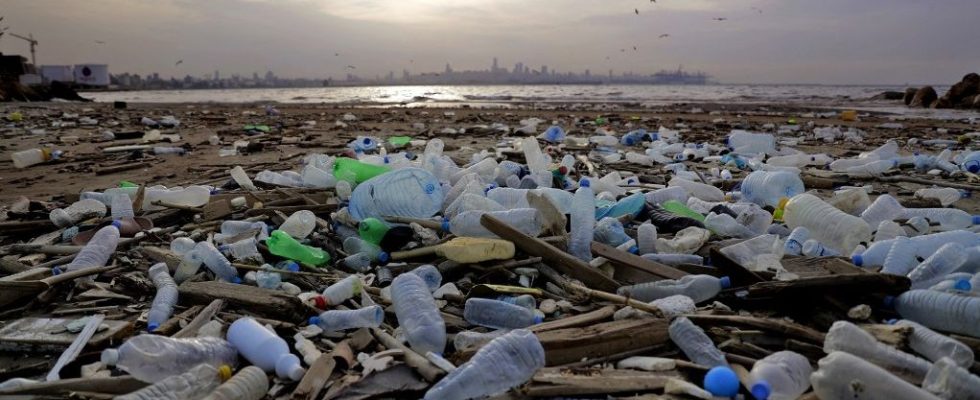In March 2022, in Nairobi (Kenya), 175 Nations pledged to develop a binding legal agreement on plastic pollution. Nine months later, a first round of negotiations brought together these same countries in Uruguay. A second will open Monday, until Friday, at the headquarters of Unesco, in Paris. With the imperative of entering a little more into the concrete. As far as hoping for a first draft of a treaty? A brief overview of the issues of the week.
Growing dependency?
“It’s not a treaty against plastic”, already frames Sophie Roux de Bézieux, president of the sea foundation, which follows the negotiations in the college of civil society actors. “In many cases, the use of this material is relevant,” she continues. The problem is that plastic proliferates and we no longer know how to manage it. »
“Nine billion tonnes have been produced since the 1950s, when we started putting plastic everywhere,” says Juliette Franquet, director of the NGO. Zero Waste France. In 2019 alone, the OECD estimates the amount of plastic produced worldwide at 460 million tonnes. “81% becomes waste in less than a year,” says Sophie Roux de Bézieux. In addition, only 19% is recycled and 22% ends up in nature”. Above all, the trend is not good: the annual production of plastic – as much as the waste generated – could triple by 2060, fears the OECD.
Plastic pollution far from being limited to the oceans?
Much has been said about the “7th continent”, this vortex of plastic waste in the middle of the Pacific Ocean. The symbol is strong, “but it’s just the tip of the iceberg”, insists Juliette Franquet. Plastic waste ranges from macro, visible to the naked eye, to nanoparticles. If we take this whole spectrum, we find plastic everywhere we look for it. » From the summit of Everest to the fresh snow of Antarctica. Behind, the impacts are multiple. Both on biodiversity and for human health or that of the soil, list Henri Bourgeois Costa, director of public affairs for the Tara Ocean Scientific Foundation. He adds the climate impact not to be forgotten, plastic being a petroleum derivative. “According to the OECD, at the rate things are going, the plastics industry will account for 17% of global CO2 emissions,” he says.
What must the treaty contain?
Henri Bourgeois Costa and Juliette Franquet insist that the solution to plastic pollution will not come from recycling but from reducing the problem at the source. “The urgency is to stabilize the annual world production and, as quickly as possible, to make it decrease”, insists the spokesman of Tara Océan. Which implies putting a lot of things in this treaty. “A key issue is to control and reduce the diversity of types of plastics on the market today. [plus de 4.000] and to do the same for the raw materials and additives used to manufacture them, to the point of banning the most toxic ones”, he explains.
Juliette Franquet adds the exit of useless plastics. Not just straws, cotton swabs, disposable cutlery and other single-use plastics that France and the European Union began to ban. It also targets packaging, which represents 36% of the plastics produced each year. “The reduction margins are significant, alternatives already existing in many cases”, abounds Henri Bourgeois Costa.
What to expect from this week in Paris?
The roadmap gives until the end of 2024 to deliver this treaty. An extremely short time for a text of this importance. It is therefore not a question of dragging on, but we are still very early in the negotiations and this Parisian round will be followed by others, including the next in Nairobi, in the fall.
Should we still hope for a first draft of a treaty by Friday? Sophie Roux de Bézieux in doubt, “even if it will be necessary to advance as much as possible”. “Above all, we must already agree on common terminologies,” she begins. What do we mean by single use, recycling and even plastic? From one country to another, the definitions are not the same” This work on definitions is a crucial point of the week also cited by Juliette Franquet and Henri Bourgeois Costa.
The latter adds a second: “It will be necessary to record the rules of governance of this future treaty, in particular the form of voting for the final text. Clearly: a vote by qualified majority or unanimously? The choice is not trivial. “For this treaty to have a strong impact, a majority of countries must sign it, but unanimity carries the risk of having to find the lowest common denominator to have all the signatures”, explains the spokesperson for Tara. Ocean. In short: to lower ambitions, a criticism that comes up regularly at the end of each COP on the climate.
Which countries are holding back with four irons?
A coalition for high ambition currently brings together 52 countries and the European Union. There is France but also Australia, Canada, Great Britain, Nigeria, Costa Rica and a multitude of small island states. This group is pushing to make this plastic treaty “a legally binding international instrument” and aiming to eliminate plastic pollution by 2040.
There are no great powers in this coalition. China, India, Brazil, the United States, Japan, Saudi Arabia…not to mention Russia. From there to say that they all brake with four irons? “For some, like China, positions remain unclear, we don’t really know what they are thinking,” begins Sophie Roux de Bézieux. “But a certain number are also hiding their very conservative positions less and less,” adds Henri Bourgeois Costa, who cites Japan, Saudi Arabia and, to a lesser extent, the United States. For fear that this plastic treaty will harm their economy? Partly, no doubt. The spokesperson for Tara Océan sees above all the oil issue: “While oil energy has some lead in the wing, industrialists in the sector see plastic production as a path to the future and exaggerate the potential of recycling. »

